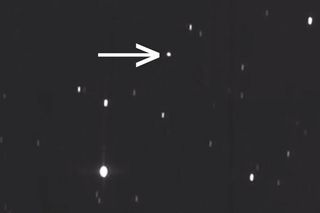This Stadium-Size Asteroid Just Zipped Safely by Earth (Video)
An asteroid the size of a sports stadium zoomed close by Earth Wednesday (March 7), and eagle-eyed stargazers captured the whole thing on camera. The asteroid won't be back again until 2026, according to NASA.
The asteroid 2017 VR12 passed within about 898,000 miles (1.4 million kilometers) at its closest point during the flyby. That's about 3.8 times the average distance between the Earth and moon (about 238,855 miles or 384,400 km), NASA officials said. [In Photos: Potentially Dangerous Asteroids]
Astrophysicist Gianluca Masi of the Virtual Telescope Project and Michael Schwartz of Tenagra Observatories in Arizona captured the video of the asteroid seen during its flyby. In the footage, the asteroid appears as a bright dot while a background of stars whizzes by.

To make the video, the telescope tracked the motion of the asteroid, which appears stationary, over the course of 122 minutes early Tuesday. Masi and Schwartz combined 240 images to make the short, 16-second video.
Asteroid 2017 VR12 is 840 feet (256 meters) across and about the size of a stadium, according to the Asteroid Watch program at NASA's Jet Propulsion Laboratory in Pasadena, California.
NASA classifies any asteroid that's larger than 492 feet (150 meters) across and that comes within 4.6 million miles (7.5 million km) of Earth as potentially hazardous. But don't worry about 2017 VR12 — it won't be coming any closer anytime soon, NASA said.

"The 2018 encounter is the closest by this asteroid currently known," scientists with NASA's Goldstone radar astronomy project wrote in an update. The asteroid's next close flyby will be on March 19, 2026, they added.
Get the Space.com Newsletter
Breaking space news, the latest updates on rocket launches, skywatching events and more!
Asteroid 2017 VR12 was discovered on Nov. 10, 2017, (hence its name) by the Pan-STARRS1 telescope in Hawaii.
NASA astronomers used the agency's Deep Space Network antenna in Goldstone, California, to take radar observations of near-Earth asteroids and learn more about the composition of passing space rocks.
Email Tariq Malik at tmalik@space.com or follow him @tariqjmalik and Google+. Follow us @Spacedotcom, Facebook and Google+. Original article on Space.com.
Join our Space Forums to keep talking space on the latest missions, night sky and more! And if you have a news tip, correction or comment, let us know at: community@space.com.

Tariq is the Editor-in-Chief of Space.com and joined the team in 2001, first as an intern and staff writer, and later as an editor. He covers human spaceflight, exploration and space science, as well as skywatching and entertainment. He became Space.com's Managing Editor in 2009 and Editor-in-Chief in 2019. Before joining Space.com, Tariq was a staff reporter for The Los Angeles Times covering education and city beats in La Habra, Fullerton and Huntington Beach. In October 2022, Tariq received the Harry Kolcum Award for excellence in space reporting from the National Space Club Florida Committee. He is also an Eagle Scout (yes, he has the Space Exploration merit badge) and went to Space Camp four times as a kid and a fifth time as an adult. He has journalism degrees from the University of Southern California and New York University. You can find Tariq at Space.com and as the co-host to the This Week In Space podcast with space historian Rod Pyle on the TWiT network. To see his latest project, you can follow Tariq on Twitter @tariqjmalik.